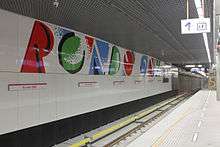Wojciech Fangor
Wojciech Fangor (15 November 1922 – 25 October 2015)[1] was a Polish painter, graphic artist, sculptor and a co-creator of the Polish School of Posters.
Wojciech Fangor | |
|---|---|
 | |
| Born | Wojciech Bonawentura Fangor 15 November 1922 Warsaw, Poland |
| Died | 25 October 2015 (aged 92) Warsaw, Poland |
| Nationality | Polish |
| Alma mater | Academy of Fine Arts in Warsaw |
| Known for | Painting, Graphic art, Sculpture |
Life and career
After privately studying art with Felicjan Kowarski and Tadeusz Pruszkowski, he obtained his diploma in 1946 at the Academy of Fine Arts in Warsaw.
He started in the Socialist realism manner, creating the “Korean Mother” (now in the National Museum, Warsaw collection).
Between 1953 and 1961, he was employed as assistant professor at the Academy of Fine Arts in Warsaw.
After the Polish October, the so-called "Gomułka's thaw" following Joseph Stalin's death, he turned away from socialist realism as a style. He became one of founders of the Polish School of Posters.
In 1961, he left Poland and settled in West Berlin between 1964–1965, in England between 1965–1966, then from 1966 in the United States, where he lectured on art at art schools. He returned to Poland in 1999.
In 1970 he had, as the sole Polish artist, an individual exhibition at the Solomon R. Guggenheim Museum in New York City.
At the time of his death he resided in Błędów, Grójec County, a village near Warsaw.
Fangor designed murals for the station walls of the second line of the Warsaw Underground in 2014.
See also
- Culture of Poland
- List of Poles
References
- Grimes, William (9 November 2015). "Wojciech Fangor, Painter Who Emerged From Postwar Poland, Dies at 92". The New York Times. Retrieved 10 November 2015.
External links
| Wikimedia Commons has media related to Wojciech Fangor. |